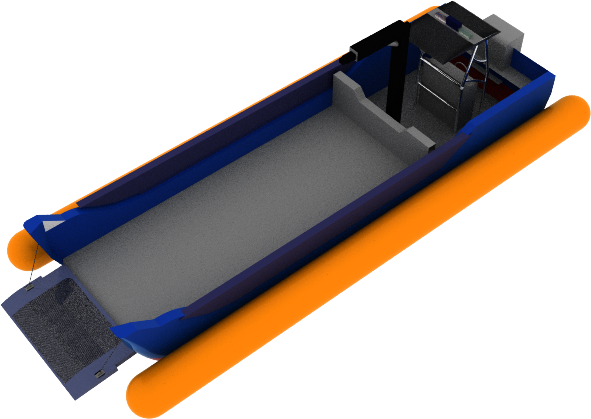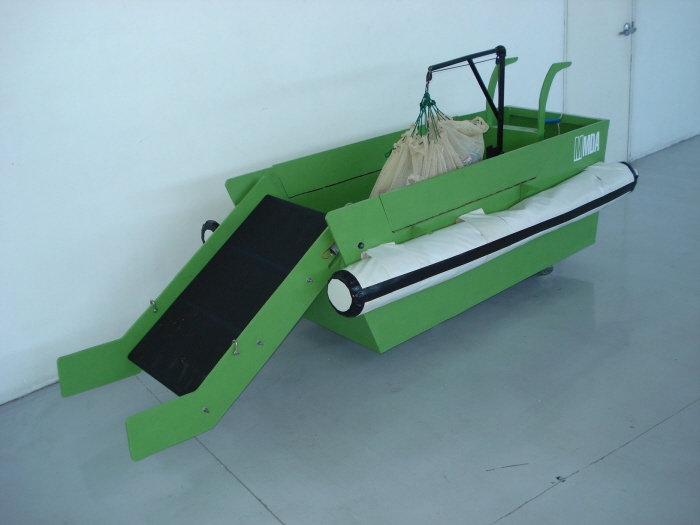
LC-1 Rendering - The LC-1 Amphora is a rapid-deployable aquatic debris removal craft designed to remove floating and lingering debris from floodwater and other aquatic cleanup situations.
The rendering was done in conjunction with naval architect Raymund Puso, who helped ensure the design's seaworthiness.

Mind Map - After the initial research, the first stage of the design involved coming up with a variety of concepts that each exemplified one of the five traits that I wanted the LC-1 to have - Velocity, Durability, Utility, Capacity and Efficiency.
These traits were expounded in a mind map, and the resulting ideas would then be developed into sketches.

Initial Concepts - After coming up with the mind map, I expanded each of the five traits into initial design sketches.
These initial concepts did not have to be realistic, enabling a highly flexible approach that would allow for more implemented solutions during refinement.

Initial Concepts - After research, the first stage of the design involved coming up with a variety of concepts that each exemplified one of the five traits that I wanted the LC-1 to have - Velocity, Durability, Utility, Capacity and Efficiency.
These initial concepts did not have to be realistic, enabling a highly flexible approach that would allow for more implemented solutions during refinement.

Initial Concepts - After research, the first stage of the design involved coming up with a variety of concepts that each exemplified one of the five traits that I wanted the LC-1 to have - Velocity, Durability, Utility, Capacity and Efficiency.
These initial concepts did not have to be realistic, enabling a highly flexible approach that would allow for more implemented solutions during refinement.

Initial Concepts - After research, the first stage of the design involved coming up with a variety of concepts that each exemplified one of the five traits that I wanted the LC-1 to have - Velocity, Durability, Utility, Capacity and Efficiency.
These initial concepts did not have to be realistic, enabling a highly flexible approach that would allow for more implemented solutions during refinement.

Initial Concepts - After research, the first stage of the design involved coming up with a variety of concepts that each exemplified one of the five traits that I wanted the LC-1 to have - Velocity, Durability, Utility, Capacity and Efficiency.
These initial concepts did not have to be realistic, enabling a highly flexible approach that would allow for more implemented solutions during refinement.

Refined Concepts - These initial concepts were then further refined into at least five different designs that leaned toward realism, though still featuring similar diversity in function.

Refined Concepts - These initial concepts were then further refined into at least five different designs that leaned toward realism, though still featuring similar diversity in function.

Refined Concepts - These initial concepts were then further refined into at least five different designs that leaned toward realism, though still featuring similar diversity in function.

Near-Final Concept - The refined concepts were finally merged into a single rendering that closely resembled what would become the final product.
I would then cooperate with a naval architect to ensure the final concept's seaworthiness.

Planning Sketches - I cooperated with a naval architect to determine exactly how the final design would come together, including determining accurate dimensions and capacity.

Planning Sketches - I cooperated with a naval architect to determine exactly how the final design would come together, including determining accurate dimensions and capacity.

Orthographic Drawing - Along with the rendering, detailed schematics were drawn up for the LC-1, including general arrangement plans, capacity plans, and electric wiring diagrams.

Rendering (Ramp Down) - Finally, I worked with a naval architect to determine the design's seaworthiness and create the design as close as it could be applied in real life.
The LC-1 has a front-mounted conveyor belt that dredges debris and garbage into the central holding area.

Rendering (Storage Area) - This holding area, which can be divided into up to four compartments to sort debris, is lined with industrial-strength nets (not shown) that can then be removed by the crane mounted toward the aft.
The crane then rotates to drag the nets over the collapsible side entrances, over the pontoons and onto a waiting barge or other transport for safe removal to a disposal site.

In-environment Rendering - Further renders were created depicting the LC-1 as it would appear in a real-life situation, to scale with the environment.

In-environment Rendering - Further renders were created depicting the LC-1 as it would appear in a real-life situation, to scale with the environment.

Finally, I constructed a functional prototype that would roughly simulate the functions of the LC-1 in its intended environment, from their inflatable pontoons to the working conveyor belt and crane.

gLike